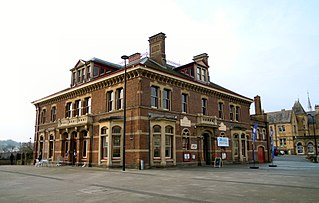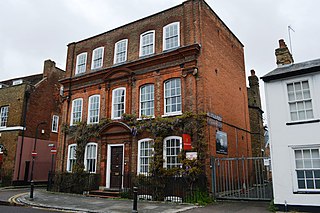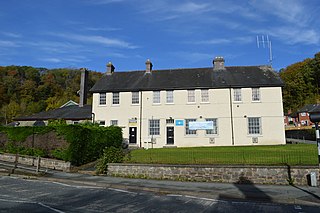
Barnstaple is a river-port town and civil parish in the North Devon district of Devon, England. The town lies at the River Taw's lowest crossing point before the Bristol Channel. From the 14th century, it was licensed to export wool from which it earned great wealth. Later it imported Irish wool, but its harbour silted up and other trades developed such as shipbuilding, foundries and sawmills. A Victorian market building survives, with a high glass and timber roof on iron columns.

The Royal Devon Yeomanry was a Yeomanry regiment of the British Army, formed in 1920. It participated in the Second World War and now forms a squadron of the Royal Wessex Yeomanry.
In countries whose armies are organised on a regimental basis, such as the army of the United Kingdom, a regimental museum is a military museum dedicated to the history of a specific army regiment.
The Royal North Devon Yeomanry was a Yeomanry regiment of the British Army. First raised in 1798, it participated in the Second Boer War and the First World War before being amalgamated with the Royal 1st Devon Yeomanry in 1920 to form the Royal Devon Yeomanry.
The Royal 1st Devon Yeomanry was a Yeomanry regiment of the British Army. First raised in 1794, it participated in the Second Boer War and the First World War before being amalgamated with the Royal North Devon Yeomanry in 1920 to form the Royal Devon Yeomanry.

Fulham House is a former military installation at 87 Fulham High Street, Fulham, London. It is a Grade II listed building.

Yeomanry House is a drill hall used by the London University Officer Training Corps in Handel Street, Bloomsbury, London.

Museum of Barnstaple and North Devon is a local museum covering the history and culture of the North Devon area and which is located in The Square in Barnstaple in Devon. The displays range from prehistoric times to the Victorian era. The building and its garden railings beside the river front have been Grade II listed since 1988.

Yeomanry House is a former military headquarters in Buckingham. It is a Grade II listed building.

Yeomanry House is a military installation in Hertford. It is a Grade II* listed building.

The Allitsen Road drill hall is a former drill hall in St John's Wood, London.

The Upper Bristol Road drill hall is a former military installation in Bath, Somerset.

The Church Street drill hall is a former military installation in Brighton. It is a Grade II listed building.

The Tower Street drill hall is a military installation on Tower Street, York. It is the Regimental Headquarters of the Royal Yorkshire Regiment. It is also home to the York Army Museum.

The High Street drill hall was a military installation in Dunkeld.

The Brook Street drill hall is a military installation in Welshpool.

The Wellington Square drill hall was a military installation in Ayr.

The Northgate Street drill hall is a former military installation in Warwick.

Yeomanry House is a former military installation in Reading, Berkshire. It is a Grade II listed building.

The Exeter & South Devon Volunteers was the premier unit of Britain's Volunteer Force. Formed in 1852 it went on to become a battalion of the Devonshire Regiment. Both its active service battalions went to garrison India on the outbreak of the First World War, and then saw action in Mesopotamia and Palestine. In the Second World War, the battalion served in the garrison of Gibraltar. It continued in the postwar Territorial Army until it was merged with other West Country units. Its successors today serve in a reserve battalion of The Rifles.


















